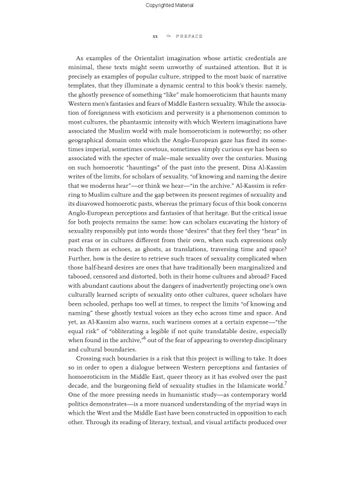Copyrighted Material
xx
• p r e fa c e
As examples of the Orientalist imagination whose artistic credentials are minimal, these texts might seem unworthy of sustained attention. But it is precisely as examples of popular culture, stripped to the most basic of narrative templates, that they illuminate a dynamic central to this book’s thesis: namely, the ghostly presence of something “like” male homoeroticism that haunts many Western men’s fantasies and fears of Middle Eastern sexuality. While the association of foreignness with exoticism and perversity is a phenomenon common to most cultures, the phantasmic intensity with which Western imaginations have associated the Muslim world with male homoeroticism is noteworthy; no other geographical domain onto which the Anglo-European gaze has fixed its sometimes imperial, sometimes covetous, sometimes simply curious eye has been so associated with the specter of male–male sexuality over the centuries. Musing on such homoerotic “hauntings” of the past into the present, Dina Al-Kassim writes of the limits, for scholars of sexuality, “of knowing and naming the desire that we moderns hear”—or think we hear—“in the archive.” Al-Kassim is referring to Muslim culture and the gap between its present regimes of sexuality and its disavowed homoerotic pasts, whereas the primary focus of this book concerns Anglo-European perceptions and fantasies of that heritage. But the critical issue for both projects remains the same: how can scholars excavating the history of sexuality responsibly put into words those “desires” that they feel they “hear” in past eras or in cultures different from their own, when such expressions only reach them as echoes, as ghosts, as translations, traversing time and space? Further, how is the desire to retrieve such traces of sexuality complicated when those half-heard desires are ones that have traditionally been marginalized and tabooed, censored and distorted, both in their home cultures and abroad? Faced with abundant cautions about the dangers of inadvertently projecting one’s own culturally learned scripts of sexuality onto other cultures, queer scholars have been schooled, perhaps too well at times, to respect the limits “of knowing and naming” these ghostly textual voices as they echo across time and space. And yet, as Al-Kassim also warns, such wariness comes at a certain expense—“the equal risk” of “obliterating a legible if not quite translatable desire, especially when found in the archive,”6 out of the fear of appearing to overstep disciplinary and cultural boundaries. Crossing such boundaries is a risk that this project is willing to take. It does so in order to open a dialogue between Western perceptions and fantasies of homoeroticism in the Middle East, queer theory as it has evolved over the past decade, and the burgeoning field of sexuality studies in the Islamicate world.7 One of the more pressing needs in humanistic study—as contemporary world politics demonstrates—is a more nuanced understanding of the myriad ways in which the West and the Middle East have been constructed in opposition to each other. Through its reading of literary, textual, and visual artifacts produced over
